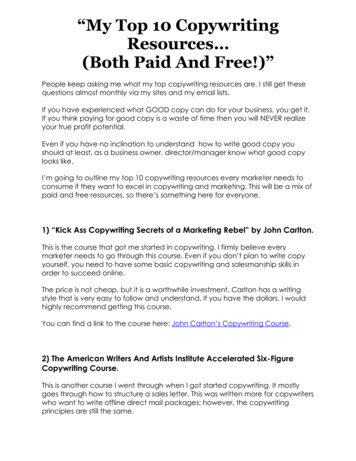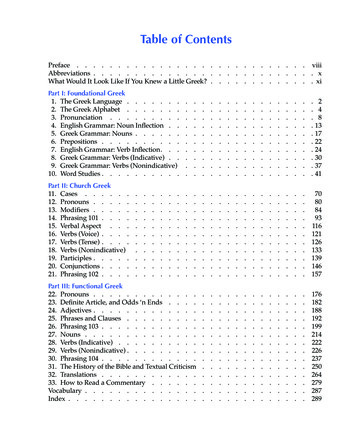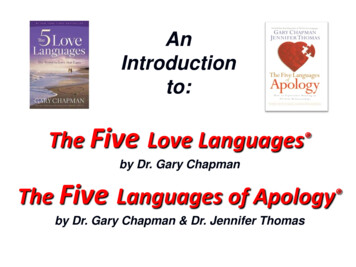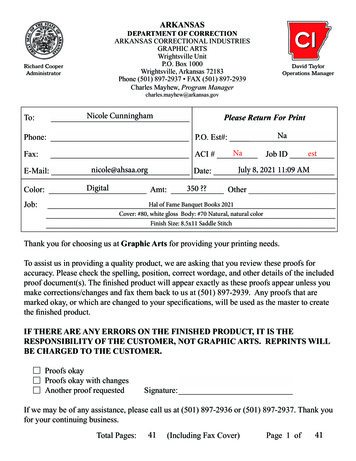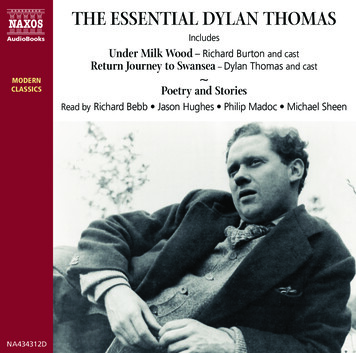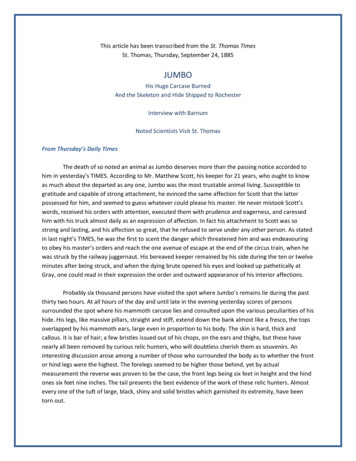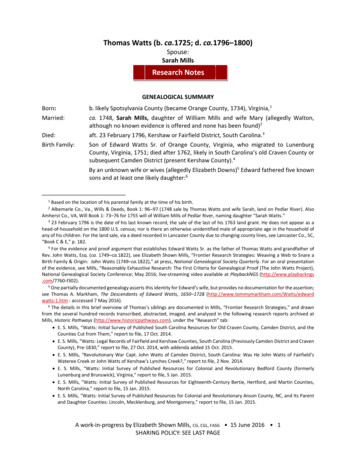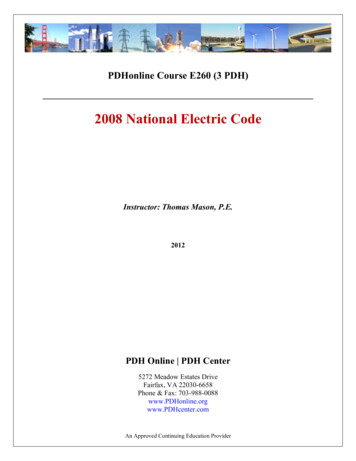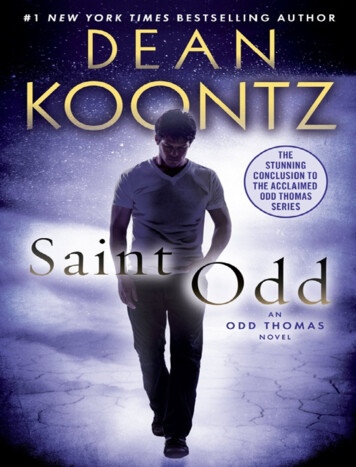
Transcription
ZONDERVANSacred MarriageCopyright 2000, 2015 by Gary L. ThomasThis title is also available as a Zondervan ebook. Visit www.zondervan.com/ebooks.This title is also available in a Zondervan audio edition. Visit www.zondervan.fm.Requests for information should be addressed to:Zondervan, 3900 Sparks Dr., Grand Rapids, Michigan 49546Library of Congress Cataloging-in-Publication DataThomas, Gary, 1961Sacred Marriage : what if God designed marriage to make us holy more thanto make us happy / Gary Thomas.p. cm.Includes bibliographical references.ISBN 978-0-310-33737-91. Spouses — Religious life. 2. Marriage — Religious aspects — Christianity. 3.Spiritual life — Christianity. I. Title.BV4596.M3 T46 2004248.4-dc 23 99 – 053471All Scripture quotations, unless otherwise indicated, are taken from The Holy Bible,New International Version , NIV . Copyright 1973, 1978, 1984, 2011 by Biblica, Inc. Used by permission. All rights reserved worldwide.Scripture quotations marked ESV are taken from The Holy Bible, English StandardVersion, Copyright 2001 by Crossway Bibles, a publishing ministry of Good NewsPublishers. Used by permission. All rights reserved.Scripture quotations marked NASB are taken from the New American Standard Bible. Copyright 1960, 1962, 1963, 1968, 1971, 1972, 1973, 1975, 1977, 1995 by The LockmanFoundation. Used by permission.Any Internet addresses (websites, blogs, etc.) and telephone numbers in this bookare offered as a resource. They are not intended in any way to be or imply an endorsement by Zondervan, nor does Zondervan vouch for the content of these sitesand numbers for the life of this book.All rights reserved. No part of this publication may be reproduced, stored in a retrieval system, or transmitted in any form or by any means — electronic, mechanical,photocopy, recording, or any other — except for brief quotations in printed reviews,without the prior permission of the publisher.Published in association with Yates & Yates, www.yates2.com.Cover design: James HallCover photography or illustration: Ksenia Palimski / Shutterstock Interior design: Matthew Van ZomerenPrinted in the United States of AmericaPrinted June 2015
CONTENTS1. THE GREATEST CHALLENGE IN THE WORLD. . . . . . . . 9A Call to Holiness More Than Happiness2. ROMANTICISM’S RUSE . . . . . . . . . . . . . . . . . . . . . . . . 14How Marriage Points Us to True Fulfillment3. FINDING GOD IN MARRIAGE. . . . . . . . . . . . . . . . . . . . 28Marital Analogies Teach Us Truths about God4. LEARNING TO LOVE . . . . . . . . . . . . . . . . . . . . . . . . . . . 39How Marriage Teaches Us to Love5. HOLY HONOR. . . . . . . . . . . . . . . . . . . . . . . . . . . . . . . . 51Marriage Teaches Us to Respect Others6. THE SOUL’S EMBRACE. . . . . . . . . . . . . . . . . . . . . . . . . 70Good Marriage Can Foster Good Prayer7. THE CLEANSING OF MARRIAGE. . . . . . . . . . . . . . . . . 82How Marriage Exposes Our Sin8. SACRED HISTORY. . . . . . . . . . . . . . . . . . . . . . . . . . . . . 97Building the Spiritual Discipline of Perseverance9. SACRED STRUGGLE. . . . . . . . . . . . . . . . . . . . . . . . . . 123Embracing Difficulty in Order to Build Character10. FALLING FORWARD. . . . . . . . . . . . . . . . . . . . . . . . . . 145Marriage Teaches Us to Forgive
11. MAKE ME A SERVANT . . . . . . . . . . . . . . . . . . . . . . . . 164Marriage Can Build in Us a Servant’s Heart12. SEXUAL SAINTS . . . . . . . . . . . . . . . . . . . . . . . . . . . . . 182Marital Sexuality Can Provide Spiritual Insightsand Character Development13. SACRED PRESENCE. . . . . . . . . . . . . . . . . . . . . . . . . . 209How Marriage Can Make Us More Aware of God’s Presence14. SACRED MISSION. . . . . . . . . . . . . . . . . . . . . . . . . . . . 228Marriage Can Develop Our Spiritual Calling,Mission, and PurposeEPILOGUE: THE HOLY COUPLE . . . . . . . . . . . . . . . . . 244Acknowledgments. . . . . . . . . . . . . . . . . . . . . . . . . . . . . . . 249Questions for Discussion and Reflection. . . . . . . . . . . . . . . . . 251Notes. . . . . . . . . . . . . . . . . . . . . . . . . . . . . . . . . . . . . . . 265
Chapter 1THE GREATESTCHALLENGEIN THE WORLDA Call to Holiness More Than HappinessBy all means marry. If you get a good wife, you’llbecome happy. If you get a bad one, you’ll become aphilosopher. SocratesI’m going to cut him open.Historians aren’t sure who the first physician was who followed through on this thought, but the practice revolutionizedmedicine. The willingness to cut into a corpse, peel back theskin, pull a scalp off a skull, cut through the bone, and actuallyremove, examine, and chart the organs that lay within was a crucial first step in finding out how the human body really works.For thousands of years, physicians had speculated on whatwent on inside a human body, but there was a reluctance andeven an abhorrence to actually dissect a cadaver. Some menrefrained out of religious conviction; others just couldn’t get9
Sacred Marriageover the eeriness of cutting away a human rib cage. While anoccasional brave soul ventured inside a dead body, it wasn’tuntil the Renaissance period (roughly the fourteenth to sixteenth centuries) that European doctors routinely started tocut people open.And when they did, former misconceptions collapsed. Inthe sixteenth century, Andreas Vesalius was granted a readysupply of criminals’ corpses, allowing him to definitively contradict assumptions about the human anatomy that had beenunquestioned for a thousand years or more. Vesalius’s anatomical charts became invaluable, but he couldn’t have drawn thecharts unless he was first willing to make the cuts.I want to do a similar thing in this book — with a spiritual twist. We’re going to cut open numerous marriages, dissectthem, find out what’s really going on, and then explore howwe can gain spiritual meaning, depth, and growth from thechallenges that lie within. We’re not after simple answers — three steps to more intimate communication, six steps to amore exciting love life — because this isn’t a book that seeksto tell you how to have a happier marriage. This is a book thatlooks at how we can use the challenges, joys, struggles, andcelebrations of marriage to draw closer to God and to grow inChristian character.We’re after what Francis de Sales wrote about in the seventeenth century. Because de Sales was a gifted spiritual director,people often corresponded with him about their spiritual concerns. One woman wrote in great distress, torn because shewanted to get married while a friend was encouraging her toremain single, insisting it would be “more holy” for her to carefor her father and then devote herself as a celibate to God afterher father died.De Sales put the troubled young woman at ease, telling herthat, far from being a compromise, in one sense, marriage mightbe the toughest ministry she could ever undertake. “The stateof marriage is one that requires more virtue and constancy thanany other,” he wrote. “It is a perpetual exercise of m ortification10
The Greatest Challenge in the World. . . In spite of the bitter nature of its juice, you may be able todraw and make the honey of a holy life.”1Notice that de Sales talks about the occasionally “bitternature” of marriage’s “juice.” To spiritually benefit from marriage, we have to be honest. We have to look at our disappointments, own up to our ugly attitudes,T his book looksand confront our selfishness. We alsoathow we can usehave to rid ourselves of the notionthe challenges ,that the difficulties of marriage canjoys , struggles ,be overcome if we simply pray harderand celebrations ofor learn a few simple principles. Mostmarriage to drawof us have discovered that these “simcloser to G odple steps” work only on a superficialand to grow inlevel. Why is this? Because there’s aChristian character.deeper question that needs to beaddressed beyond how we can “improve” our marriage: What ifGod didn’t design marriage to be “easier”? What if God had anend in mind that went beyond our happiness, our comfort, andour desire to be infatuated and happy, as if the world were a perfect place?What if God designed marriage to make us holy more thanto make us happy? What if, as de Sales hints, we are to acceptthe “bitter juice” because out of it we may learn to draw theresources we need with which to make “the honey of a holy life”?This isn’t to suggest that happiness and holiness are contradictory. On the contrary, I believe we’ll live the happiest, mostjoy-filled lives when we walk in obedience. John Wesley onceboldly proclaimed that it is not possible for a man to be happywho is not also holy, and the way he explains it makes much sense.Who can be truly “happy” while filled with anger, rage, and malice?Who can be happy while nursing resentment or envy? Who canbe honestly happy while caught in the sticky compulsion of aninsatiable lust or incessant materialism? The glutton may enjoy hisfood, but he does not enjoy his condition.So we’re not anti-happiness; that would be silly. The problem I’m trying to address is that a “happy marriage” (defined11
Sacred Marriageromantically and in terms of pleasant feelings) is too often theendgame of most marriage books (even Christian marriagebooks). This is a false promise. You won’t find happiness at theend of a road named selfishness.This is a book that looks and points beyond marriage. Spiritual growth is the main theme; marriage is simply the context.Just as celibates use abstinence and religious hermits use isolation, so we can use marriage for the same purpose — to growin our service, obedience, character, pursuit, and love of God.For centuries, Christian spirituality was virtually synonymous with celibate spirituality; that is, even married peoplethought we had to become like monks and nuns to grow inthe Lord. We’d have to do the same spiritual exercises, bestperformed by single people (long periods of prayer that don’tallow for child rearing or marital discussion, seasons of fastingthat make preparing meals difficult for a family, times of quietmeditation that seem impossible when kids of any age are inthe house), rather than seeing how God could use our marriages to help us grow in character, in prayer, in worship, andin service. Rather than develop a spirituality in which marriage serves our pursuit of holiness, the church focused on howclosely married people could mimic “single spirituality” without neglecting their family. The family thus became an obstacle to overcome rather than a platform to spiritual growth.The reason the marriage relationship is often seen as a selfishone is because our motivations for marrying often are selfish.But my desire is to reclaim marriage as one of the most selflessstates a Christian can enter. This book sees marriage the waymedieval writers saw the monastery: as a setting full of opportunities to foster spiritual growth and service to God.You’ve probably already realized there was a purpose foryour marriage that went beyond happiness. You might nothave chosen the word holiness to express it, but you understood there was a transcendent truth beyond the superficialromance depicted in popular culture. We’re going to explorethat purpose. We’re going to cut open many marriages, find12
The Greatest Challenge in the Worldout where the commitment rubs, explore where the poisonedattitudes hide, search out where we are forced to confront ourweakness and sin, and learn how to grow through the process.We’ll also look at what Scripture, church history, and theChristian classics can tell us. You’ll find that the classics areamazingly relevant and that the past influences the present farmore than many people think.The ultimate purpose of this book is not to make you loveyour spouse more — although I think that will happen alongthe way; it’s to equip you to love your God more and to helpyou reflect the character of his Son more precisely. At the veryleast, you’ll have a new appreciation for the person with whomyou have embarked on this journey.I also pray it will help you to love your marriage more,appreciate your marriage more, and inspire you to become evenmore engaged in your relationship with your spouse. When yourealize something is “sacred,” far from making it boring, it givesbirth to a new reverence, a take-your-breath-away realizationthat something you may have been taking for granted is farmore profound, far more life-giving and life-transforming, thanyou may ever have realized.T he ultimate purposeI love marriage, and I love myof this book is notmarriage. I love the fun parts, theto make you love youreasy parts, and the pleasurable parts,spouse more ; it ’ sbut also the difficult parts — theto equip you to loveparts that frustrate me but help meyour G od more .understand myself and my spouseon a deeper level; the parts that are painful but that crucify theaspects of me that I hate; the parts that force me to my kneesand teach me that I need to learn to love with God’s love insteadof just trying harder. Marriage has led me to deeper levels ofunderstanding, more pronounced worship, and a sense of fellowship that I never knew existed.“Sacred” isn’t my brand; it’s my way of life. And applying itto my marriage has transformed every one of my days. I believeit can do the same for you.13
Chapter 2ROMANTICISM’SRUSEHow Marriage Points Us toTrue Fulfillment Like everything which is not the involuntary result offleeting emotion but the creation of time and will, anymarriage, happy or unhappy, is infinitely more interesting than any romance, however passionate.W. H. AudenWhile holiness as a goal of marriage may sound like aradically different view of marriage, the very concept of“romantic love,” which is celebrated in movies, songs, and novels,was virtually unknown to the ancients. There were exceptions — one need merely read Song of Songs, for instance — but takenas a whole, the concept that marriage should involve passionand fulfillment and excitement is a relatively recent development on the scale of human history, making its popular entrytoward the end of the eleventh century.1This is not to suggest that romance itself or the desire for14
Romanticism’s Rusemore romance is necessarily bad; after all, God created theromantic component of our brain chemistry, and good marriages work hard to preserve a sense of romance. But the ideathat a marriage can survive on romance alone, or that romanticfeelings are more important than any other consideration whenchoosing a spouse, has wrecked many a marital ship.Romanticism received a major boost by means of the eighteenth-century Romantic poets — Wordsworth, Coleridge,and Blake — followed by their successors in literature, Byron,Shelley, and Keats. These poets passionately argued that it wasa crime against oneself to marry for any reason other than“love” (which was defined largely by feeling and emotion), andthe lives of many of them were parodies of irresponsibility andtragedy.For example, one of the writers who embraced this romanticnotion with fervor was the sensuous novelist D. H. Lawrence,whose motto was “With should and ought I shall have nothingto do!” Lawrence fell in love with Frieda Weekley, a marriedwoman, and sought to woo Frieda away from her husband,as his “love” demanded he do. As part of his less-than-nobledesigns, Lawrence sent Frieda a note, proclaiming that she wasthe most wonderful woman in all of England.Being married with three children and having already suffered a couple of affairs, Mrs. Weekley saw through Lawrence’semotion and coolly replied that it was obvious to her he hadnot met many Englishwomen.2In her startling and insightful essay on marriage writtenin the 1940s (titled, interestingly enough, “The NecessaryEnemy”), twentieth-century writer Katherine Anne Porterbemoaned how “Romantic Love crept into the marriage bed,very stealthily, by centuries, bringing its absurd notions aboutlove as eternal springtime and marriage as a personal adventure meant to provide personal happiness.”3 The reality ofthe human condition is such that, according to Porter (andI agree), we must “salvage our fragments of happiness” out oflife’s inevitable sufferings.415
Sacred MarriagePorter carefully explores the heights and depths of marriage,making the following observations about a young bride:This very contemporary young woman finds herself facing theoldest and ugliest dilemma of marriage. She is dismayed, horrified, full of guilt and forebodings because she is finding outlittle by little that she is capable of hating her husband, whomshe loves faithfully. She can hate him at times as fiercely andmysteriously, indeed in terribly much the same way, as oftenshe hated her parents, her brothers and sisters, whom sheloves, when she was a child . . . She thought she had outgrownall this, but here it was again, an element in her own natureshe could not control, or feared she could not. She would haveto hide from her husband, if she could, the same spot in herfeelings she had hidden from her parents, and for the same nodoubt disreputable, selfish reason: she wants to keep his love.5With only a romantic view of marriage to fall back on, Porter warns, a young woman may lose her “peace of mind. She isafraid her marriage is going to fail because . . . at times she feelsa painful hostility toward her husband, and cannot admit itsreality because such an admission would damage in her owneyes her view of what love should be.”6Romantic love has no elasticity to it. It can never be stretched;it simply shatters. Mature love, the kind demanded of a goodmarriage, must stretch, as the sinful human condition is suchthat all of us bear conflicting emotions. “Her hatred is real asher love is real,” Porter explains ofRomantic love hasthe young wife.7 This is the realityno elasticity toof the human heart, the inevitabilityit . I t can never beof two sinful people pledging to livestretched ; it simplytogether, with all their faults, for theshatters .rest of their lives.A wedding calls us to our highest and best — in fact, toalmost impossible — ideals. It’s the way we want to live. Butmarriage reminds us of the daily reality of living as sinfulhuman beings in a radically broken world. We aspire after lovebut far too often descend into hate and apathy.16
Romanticism’s RuseAny mature, spiritually sensitive view of marriage must bebuilt on the foundation of mature love rather than romanticism. But this immediately casts us into a counterculturalpursuit.In his classic work The Screwtape Letters, C. S. Lewissatirically ridicules our culture’s obsession with romanticism.The demon Screwtape, a mentor to the demon Wormwood,gloats:Humans who have not the gift of [sexual abstinence] can bedeterred from seeking marriage as a solution because they donot find themselves “in love,” and, thanks to us, the idea ofmarrying with any other motive seems to them low and cynical. Yes, they think that. They regard the intention of loyaltyto a partnership for mutual help, for the preservation of chastity, and for the transmission of life, as something lower thana storm of emotion.8I think most of us who have been married for any substantial length of time realize that the romantic roller coasterof courtship eventually evens out to the terrain of a Midwestinterstate — long, flat stretches with an occasional overpass.When this happens, couples respond in different ways. Manywill end their relationship and try to re-create the passionateromance with someone else. Other couples will descend intoa sort of marital guerrilla warfare asW e can run fromeach partner blames the other forthe challenges ofpersonal dissatisfaction or lack ofmarriage , or we canexcitement. Some couples decideadmit that everyto simply “get along.” Still othersmarriage presentsmay opt to pursue a deeper meanthese challenges anding, a spiritual truth hidden in theasks us to addressenforced intimacy of the maritalthem head - on .situation.We can run from the challenges of marriage — as doctorsdid from the human body, refusing to cut open the cadaversand really look at what was going on — or we can admit thatevery marriage presents these challenges and asks us to address17
Sacred Marriagethem head-on. If we find that the same kinds of challengesface every marriage, we might assume God designed a purpose in this challenge that transcends something as illusoryas happiness.This book looks for that purpose and meaning and asks thisquestion: How can we discover in the challenges of marriagethe opportunities to learn more about God, grow in our understanding of him, and learn to love him more?Numerous married couples have opened up their lives forus in this book, so I suppose it’s only fair that I should allow myown marriage to be dissected first.AN UNEXPECTED ENGAGEMENTLisa and I often wonder what would have happened if she hadsaid yes.During a free afternoon at a college campus ministry retreatwhen we were still dating, I asked Lisa to join a group of us fora round of Frisbee golf.“No thanks,” Lisa said. “I think I’ll go for a walk instead.”She had recently returned from a summerlong mission tripto Mexico, and this retreat was supposed to be a time when Lisaand I could reconnect. We had known each other since juniorhigh and had been dating for about a year, and we were getting“serious.” Unknown to Lisa, I had asked my best friend, RobTakemura, to begin praying about whether I should ask Lisato marry me. And unknown to me, Lisa and her mother hadspent a Saturday afternoon the week before looking at weddingdresses, “just in case” Lisa should ever need one.I was somewhat frustrated that Lisa wasn’t being cooperative, so I said, “Fine, I won’t play Frisbee golf either.”“You can,” Lisa said. “I don’t mind walking alone.”“No, I’ll go with you,” I said.We walked along the river, set inside a stunning valley onthe outskirts of Glacier National Park, and talked for aboutforty-five minutes. Suddenly, I stopped skimming rocks, andvirtually out of nowhere I said to Lisa, “I want to marry you.”18
Romanticism’s RuseLisa’s mouth dropped open.“Is that a proposal?” she asked, astonished.I shook my head yes, just as astonished as she was. Lisacame up and hugged me.“Is that an acceptance?” I asked, and Lisa nodded in theaffirmative.“Whew,” she said after a brief moment. “Imagine if I hadagreed to play Frisbee.”We laughed about it and then experienced one of themost intense times emotionally I’ve ever known. There wasa strange, almost mystical commingling of souls. Somethingwas going on inside us, around us, and through us that superseded any physical connection. It was somehow deeper, moremeaningful, and more amazing than anything we had everexperienced.Over the next nine months, we made plans, as any engagedcouple does. We talked about mission work, family, seminary,serving God — you name it. It was an intense time, and weoften prayed, “Lord, wherever you want to take us, howeveryou want to use us, we’re all yours.”We never slept together until our wedding night, so ourhoneymoon was a rather intoxicating experience, but once thehoneymoon was over, reality immediately set in like a denseSeattle fog.Because I was planning to save up money for seminary, wespent our first few months living in a very tiny home, offeredto us rent-free by a family friend. I left for work two days afterwe got back, and Lisa was stranded in a small community, outin the middle of nowhere, and she began to cry.It was a sunny day, so she called me at work and asked if Icould come home early so we could drive to a lake. I thoughtshe was crazy. “I can’t just leave work because the weather’snice!” I protested. “Besides, I just started this job!”“Well, what’s the use of getting married if I see you less nowthan when we were engaged?” she complained.What’s the use, indeed?19
Sacred MarriageFast-forward ten years. We had three small children, twoof them in diapers. I was working for a Christian ministry,and we were still “just making it” financially, snuggled into atown house in northern Virginia. We were about to enter our Friday-night ritual — laundry and a rented movie.“What do you want to watch?” I asked Lisa as I gatheredmy keys and headed out the door.“Oh, how about a romantic comedy?” Lisa answered.I cringed. The last three videos we had watched togetherhad been romantic comedies. I couldn’t bear to watch anotherimpossibly beautiful couple “meet cute” under extremelyimprobable circumstances, fall in love, get in a fight, and thenspend sixty minutes falling back in love again.I sighed, looked at Lisa, and said. “I’m sorry. I just can’t doit. I have to see at least one building blow up and one car crash.If I can find something that has a little romance to add to that,I’ll see what I can do.”I took three steps out the door, then thought to myself,When did “Please, God, change the world through us” suddenlybecome “Should we watch Arnold Schwarzenegger or Julia Roberts?” I didn’t remember any fork in the road or any flashingneon signs that pointed in that direction, but somehow, somewhere, it had happened.I remembered the intensity ofW hat was this thingthe night on which we had becomecalled marriage ?engaged, the joyful exploration ofHow had I endedour honeymoon, filling out a preup here ? W as thereliminary application for a missionno more purposeorganization, bringing our first childto it than this ?home — but now, ten years later, wehad “evolved” into spending Friday nights watching other peoplefall in love according to the machinations of a Hollywood script.That night I didn’t have any answers, but taking an honestlook at my situation definitely shook me awake. What was thisthing called marriage? How had I ended up here? Was there nomore purpose to it than this?20
Romanticism’s Ruse“IT IS GOOD FOR A MAN NOT TO MARRY”I became a Christian at a very young age. In truth, I canscarcely remember a moment when God was not an active andconscious presence in my life. Because of this, I felt drawn to Jesus early on.I was drawn to more than Jesus, however; I also rememberbeing drawn to girls. I had a pretty big crush on a dark-hairedgirl in kindergarten! The first time I actually held hands witha girl was in fifth grade. Tina and I rolled around the skatingrink, both of us blushing as the Carpenters’ melodious harmonies described us well: “I’m On Top of the World.” It sure feltlike it!As I grew older, both of these movements — toward J esusand toward females — sometimes created an uneasy tension.The man I most admired, the one person on whom I wantedto model my life was a single man. As a big fan of the Christian classics — ancient books focused on building intimacywith God — I was fully aware of the long-standing traditionof celibacy — monks and nuns who lived out their dedicationto God by pledging to abstain from marriage and sex. BecauseI knew their love for God was so intense, part of me wished Icould embrace this; I wanted to be sold-out for Christ, and incollege I struggled with the apostle Paul’s words, “It is good fora man not to marry” (1 Corinthians 7:1, as found in the 1984edition of the NIV).9In fact, there is much in Christian history that has unofficially (and at times blatantly) considered married believers tobe second-class Christians who compromised their integrity orwere too weak to contain their sexual urges. Augustine thoughthe was being charitable when he wrote, referring to the intentto procreate, “Marital intercourse makes something good outof the evil of lust.”10 Scripture may be infallible, but Christianhistory isn’t, and unfounded prejudices do exist.There’s no question that the “first pope,” Peter, was married. ( Jesus couldn’t very well have healed Peter’s mother-inlaw if Peter didn’t have a wife!) But there is also evidence in21
Sacred MarriageScripture (1 Timothy 5:9 – 12) that during the first centuryyoung widows were already taking vows of celibacy. By AD110, celibates could take vows that mirrored marital vows. Thisbecame a little more institutionalized so that by the third century, lifelong vows of celibacy were not uncommon. By thefourth century, such vows were commemorated by a full liturgical celebration.11Although Christianity was born out of Judaism, a religion in which marriage was considered a religious duty (onerabbi suggested that a man who does not marry is not fully aman),12 it wasn’t long until married believers were scarcely anafterthought during centuries of writing on spiritual theology(studying how Christian believers grow in their faith, learn topray, and draw closer to God). Most of the Christian classicswere written by monks and nuns for monks and nuns. Themarried could at best feebly try to simulate a single pursuitof God; the thought of pursuing God through marriage wasn’treally given serious consideration;T here is much ininstead, the emphasis was largely onChristian historypursuing God in spite of marriage.that has unofficiallyI carried some of this baggage intoconsidered marriedmy own relationship, but early on, mybelievers to beeyes were opened to a different reality.second - classI remember my brother asking me aChristians whofew questions about what marriagecompromised theirwas like. I thought for a momentintegrity or wereand said, “If you want to be free totoo weak to containserve Jesus, there’s no question — staytheir sexual urges . single. Marriage takes a lot of time.But if you want to become more like J esus, I can’t imagine anybetter thing to do than to get married. Being married forces youto face some character issues you’d never have to face otherwise.” Ihad begun to realize I could further pursue God through marriageand not just in spite of it. Marriage didn’t need to hold me backfrom my spiritual goals; it could actually help me reach them. Jesus, of course, was celibate his entire life, so it’s somewhat22
Romanticism’s Ruseironic to suggest that marriage is the preferred route to becoming more
All Scripture quotations, unless otherwise indicated, are taken from The Holy Bible, New International Version . who is not also holy, and the way he explains it makes much sense. Who can be
